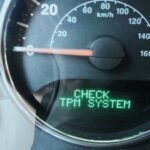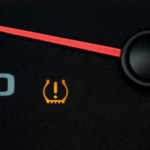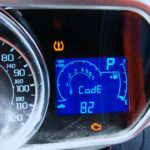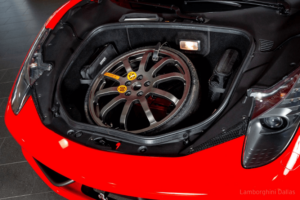If your car has a Tire Pressure Monitoring System, you won’t have a problem with underinflated or overinflated tires. American car manufacturers adopted the TPMS in 2007. Where is the TPMS reset button in your car?
Typically, the TPMS button of a car is located under the steering wheel. To find this button in your vehicle, consult your owner’s manual. It’s important to know where to find this button because there are times when you need to reset it.
The TPMS uses several sensors to monitor the air pressure inside your tires. You can find these sensors mounted on the valve stem of each tire. Even your spare tire has a sensor. Because of the delicate location of the sensors, you should take special care when mounting or dismounting your tires.
Read on to learn more about the location of the TPMS reset button, how to reset it, and what a TPMS does.
Where Is the TPMS Reset Button?

The TPMS reset button is under the vehicle’s steering wheel. To be sure about its location in your car, you have to refer to your owner’s manual. You need to know where it is located because, from time to time, you have to reset it.
TPMS is short for Tire Pressure Monitoring System. This system uses several sensors mounted on the tires to monitor the air pressure inside the tires. It checks if your tires are underinflated or overinflated and sends the appropriate signals to the car computer.
If a tire is underinflated or overinflated, it will trigger the TPMS indicator light on your dashboard to warn you.
After fixing the issue, reset the TPMS button so the light will no longer blink on your dash. You cannot reset it if you don’t know where this reset button is located. So, you may think knowing its location is not a big deal. But it is when you need to reset it.
In working with the TPMS, you should not damage the sensors mounted on the tires. These sensors are usually located on the tire’s valve stem, specifically on the inboard side of the tire bead.
But there are some car manufacturers which mount the sensors to a band of metal that is clamped around the center circumference of the rim. You can easily damage these sensors if you are not careful in mounting or dismounting your tires.
What Is a TPMS?
The Tire Pressure Monitoring System is used to inform you of the current inflation pressure of your tires. It is a crucial component of your car’s safety features. That is why you must ensure it is always active and working correctly when driving your vehicle.
The TPMS of your car consists of several sensors mounted on each of the tires to monitor the air pressure inside them. If just one of the tires gets underinflated, the TPMS indicator light will flash on your dash. This yellow light turns on to warn you of the fact.
Most cars manufactured after 2014 are equipped with this safety feature. Any vehicle that does not use a TPMS may not pass the standard vehicle safety tests of traffic authorities in the United States and most governments worldwide.
You can derive certain benefits from the TPMS of your vehicle. These benefits are mostly connected to the handling and safety of a car:
- Minimizes tire failures
- It gives a visual warning of low tire pressure while driving
- Helps in optimizing fuel economy
- Maintains the original handling of the vehicle
- Reduces tire wear because of underinflated or overinflated tires
What Wakes Up a TPMS Light?

A battery powers the TPMS sensors. When the TPMS indicator light flashes on your dash, it often means you need to replace this battery. However, other triggers can cause the TPMS indicator light to blink.
Perhaps there’s a problem with the sensors themselves. Different triggers can cause the TPMS indicator to turn on. What are these triggers?
1. Bad Sensor
Sensors are delicate instruments. If handled carefully, they will last long. Otherwise, they can deteriorate quickly. So, if a sensor is not adequately taken care of during the mounting or dismounting of the tire, it will trigger the TPMS light on your dash.
Sensors can also go bad if your tire or tires accidentally hit the curb. This incident is enough to damage the sensor. Even without such incidents, at some point in the life of your car, you need to replace the sensors on your tires as they will deteriorate.
2. Underinflated or Overinflated Tire
The primary objective of the TPMS is to monitor the air pressure inside your tires. So, any deviation from the set air pressure will trigger its indicator light. This is to help you maintain the correct tire pressure in all your tires to optimize your driving experience.
3. Sensor Battery Discharge
Small batteries are used to power the sensors of the TPMS. At some point in time, these batteries will discharge. As these batteries approach the end of their lives, the indicator light of the TPMS will blink on your dash.
These tiny batteries are irreplaceable. So, if this is the issue of the TPMS, you can’t do anything but replace the bad sensor or sensors. This work is a bit complicated. A qualified mechanic must perform it.
4. TPMS Sensor Fault
When a sensor can no longer report correct information to the computer, your car will store a TPMS Fault code.
Its indicator light on your dash will flash to inform you that the car’s TPMS is not working correctly. If you replace the bad sensor, the stored fault code will only be erased in the car computer’s memory.
Sometimes, your dash will warn you about a TPMS Fault. Each trigger that I mentioned above can cause a TPMS Fault. As in all the components of your car, no matter how well you take care of it, the TPMS will eventually fail.
You can’t help it that at some point in the life of your vehicle, especially if it is your daily ride, there will come a time when its TPMS will manifest some problems. You need to fix the issue as it appears on your vehicle.
Qualified mechanics better handles car sensor issues. Even if you are an experienced DIYer, it is recommended that you ask the help of a certified mechanic specializing in car sensors to do the work.
Again, where is the TPMS reset button? The TPMS reset button is usually under the steering wheel. If you still can’t find it, check your manual.
Can You Still Drive With a TPMS Fault?

While you can still drive with a TPMS Fault on your dash, you are advised not to do so. If you have this fault on your vehicle, your TPMS is no longer working.
While the TPMS can inform you about this fault, it can’t warn you about what it can report. In short, your safety on the road is at risk.
You should fix this issue as soon as you can. Bring your vehicle to a certified mechanic so they can diagnose and pinpoint the exact cause of the problem and ask them to fix it immediately. Replacing a sensor is not as expensive as before.
So, if a bad sensor is the cause of the problem, there is no reason why you can’t replace it. Your safety on the road should always be your priority. Driving with underinflated or unbalanced tires is dangerous and can also exact some toll on the tires and fuel consumption.
What to Do If the TPMS Light Comes On?
If you are driving and the TPMS light suddenly pops up on your dash, you should stop at the nearest gas station and check the air pressure in all the tires. Perhaps one or two or all of your tires are underinflated.
The air pressure inside your tires can go down for two reasons:
- A sharp object punctured your tire or tires on the road and the air inside leaks.
- A sudden decrease in the outside temperature: As the temperature drops, air contracts get denser and take up less space. This means the pressure inside your tires will go down.
If the nearest gas station is just a few miles away, you can still drive until you reach it and have your tire pressure checked. However, if it is still far away, install your spare tire before driving. It will be a lot safer.
How to Reset the TPMS Light?
After fixing the issue, you should reset the TPMS light. You are advised not to reset the light until you have corrected the cause of the problem. Here are the steps you need to follow to reset the TPMS light:
1. Drive the Vehicle
Drive your vehicle at or more than 50 miles per hour for about 10 minutes. As you drive your car, the TPMS light will reset itself.
The next time you start your car, the TPMS light will act normally. It lights up a few seconds after you turn the engine on and will fade out shortly after.
2. Turn Off the Engine
Turn off the engine. Then turn the ignition key to the “On” position, but don’t start the engine yet. Hold the TPMS reset button until the light flashes three times. Release the button. Start your car and let the engine idle for around 20 minutes. This will refresh the TPMS sensors.
3. Inflate, then Deflate, and then Inflate Your Tires
Inflate your tires 3 PSI more than the recommended air pressure of your tires. Then deflate them to zero pressure. Include the spare tire. Once all your tires are deflated, re-inflate them to their recommended tire pressure.
4. Disconnect the Positive Cable of the Car Battery
Turn off the engine and then disconnect your car battery’s positive (black) cable. Turn on the engine and press the car horn for around three seconds.
This action will discharge the power in your car’s other electrical devices. After this, reconnect the positive cable of your battery.
In Closing
The TPMS reset button of a car is usually located under the steering wheel. You should read your owner’s manual for your vehicle to know where it is located. You need to know where it is located because there will be times when you must reset this button.
Be careful when working with the TPMS on your tires. This system uses several sensors to monitor the air pressure inside your tires. And these sensors can easily break if not handled properly and carefully.



![Ford Sync Phone Button Not Working [Causes and How to Fix] Ford Sync Phone Button Not Working](https://roadsumo.com/wp-content/uploads/2022/03/Ford-Sync-phone-button-not-working-150x150.jpg)
![What Is DTC in a BMW [DTC Warning Light and Button Explained] what does the dtc light mean on a bmw](https://roadsumo.com/wp-content/uploads/2022/05/what-does-the-dtc-light-mean-on-a-bmw-150x150.jpg)
![Mercedes Air Conditioning Reset [How to] mercedes air conditioning reset](https://roadsumo.com/wp-content/uploads/2021/07/mercedes-air-conditioning-reset-150x150.jpg)


![Read more about the article Walmart Tire Rotation Cost [What Does Walmart Charge?]](https://roadsumo.com/wp-content/uploads/2021/07/walmart-tire-rotation-cost-300x200.jpg)
